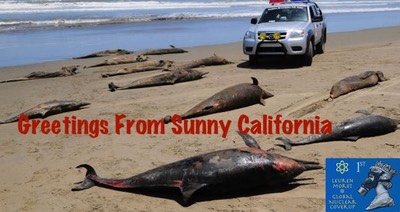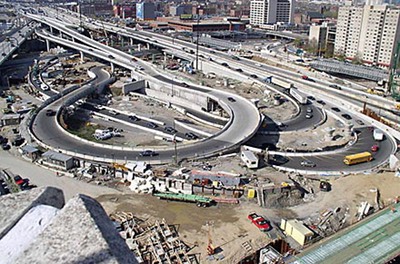💀✠💣✠💀✠💣✠💀✠💣✠💀✠💣✠💀✠💣✠💀✠💣✠💀✠💣✠💀✠💣✠💀✠💣✠💀✠💣✠💀✠💣✠💀✠💣✠
Conflict journalism, Eyewitness Accounts, Genocide in Ukraine, Humanitarian Crisis, Interviews & Accounts, Ukrainian War Crimes, War reporting
Exodus from the “City of the Dead”
Posted by babeuf79 ⋅ February 16, 2015 ⋅ 28 Comments
Filed Under Civilians, Debaltsevo, Donbass, DPR, DPR. Militia, Humanitarian Crisis, Makeevka, Militia, Militiaman Gogi, Refugees, Shelling, Uglegorsk, Ukraine, Ukrainian Army
Original: Komsomolskaya Pravda
Translated by Alya Bailey / Edited by @GBabeuf
Photo credits: Aleksandr Kots, Dmitriy Steshin
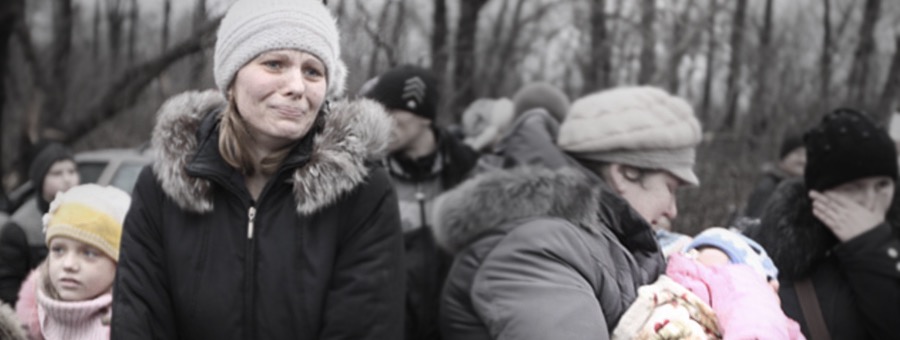
The Militia opened a humanitarian corridor for the residents and organised the evacuation. The Ukrainian side did not want to let the civilians cross their front line.
People started leaving the town early in the morning. We ran into the first group of refugees already on Gorlovka’s outskirts. Packed cars with windows steamed on the inside and white sheets, scarves on aerials and mirrors. People had hardly any belongings with them—they escaped with only the clothes they were wearing and had filled the vehicles to the brim. Then we saw a few Urals with children in the cabs. The first transfer point is at the administrative building of one of the mines. Here, the Militia is checking ID papers—a lot of Ukrainian soldiers are left in the city, hiding in basements, abandoned flats and houses. There are no delays here—passports are quickly looked at and everyone goes on to Makeevka, where the refugees are fed and dispersed to temporary accommodation.
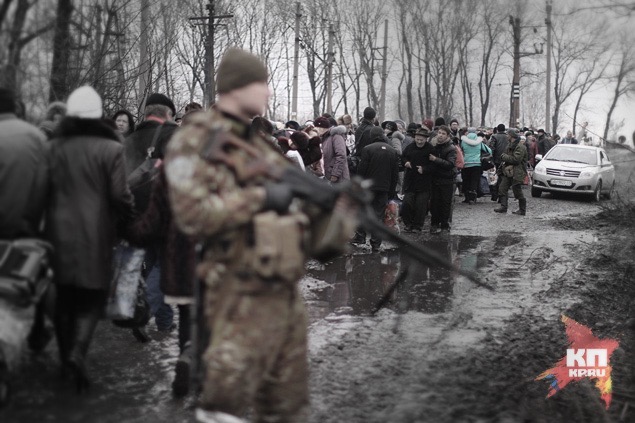
The city centre, so to say, is no more,” says one resident, Lyudmila Vladimirovna. “The day before yesterday it was demolished by Grads launched from Debaltsevo. What corridors? We’re escaping by ourselves. Getting out of the basements and running. We live in the outskirts, so we don’t know anything. There’s no communications. No power, nowhere to charge your phone.”
“We escaped from Uglegorsk,” a man says. “There’s firing there. There’s nothing left of Uglegorsk. In our house the third floor is burnt out, the second floor is holed. And the Grads come at us from Debaltsevo at will.”
“My parents remain in Groznoe village, near Uglegorsk, I don’t know how to get them out of there,” cries a woman, Valya. “Everything’s smashed. Three days we’ve lain on the floor in the flat. Then we managed to get to the basement, we crawled there. Five days we couldn’t leave, couldn’t leave the house—they were firing at us. I don’t know who it was—they were flying the Ukrainian flag. They were running around the entrances to our blocks of flats firing their guns. Twice our house was shelled.”
“Were you scared?” we ask a boy sitting on the front seat of a minibus. “No!” he shouts. The little boy seems to be shell-shocked. “I hid in the basement with mummy.”
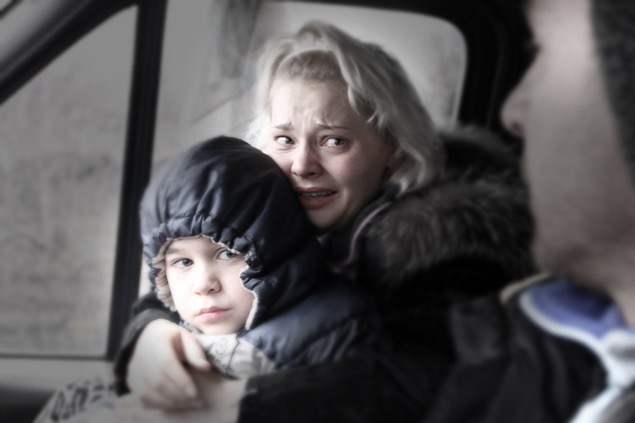
“There are elderly people on 7 Stankevskogo Street. They’re disabled, they can’t get down from the third floor,” escaping refugees shout to us from inside a minibus. “Let Poroshenko live like we are now! Let his children endure all this!”
It is unusually quiet—the soldiers confirm: the ceasefire will last till 1pm. We drive another dozen kilometres to the outskirts of Uglegorsk. All fields around the road are mined, and sappers are already at work on them, the ground studded with metal rods topped with red triangles, placed above located mines. In the middle of a minefield, in a puddle of melted snow stands an office chair—neither logic nor imagination can explain how it could have got there. At the first houses of Uglegorsk, at the obliterated railway crossing, we can see an endless queue of dejected people waiting to embark in the morning dark. People keep coming out of the town on the only open road. They are carrying bundles, bales and checkered plastic bags that have long since become a symbol of woe, poverty and suffering.
The mud is knee deep and people walk through it in expensive footwear, in fur coats dripping at the hem—people put on their most expensive things. They carry everything they can by themselves. A smartly clad little girl is carrying a cat in a cage. A poorly dressed old woman leans with every step on her bundle of belongings. Everything inside it is probably already soaked with mud and water. Trucks move towards the queue of the refugees one after another. Just before getting in, people cats away bicycles, pushchairs and trolleys. Tens of abandoned little dogs twirl around ones feet. A Militiaman who directs the loading is followed by an incredibly dirty collarless thoroughbred German shepherd. His ears move sensitively, catching every word from his new master. He seems to be very lucky in this eerie situation. People grab our hands:
“Guys, from Russia? From TV? Can we tell the camera, we’re alive?”
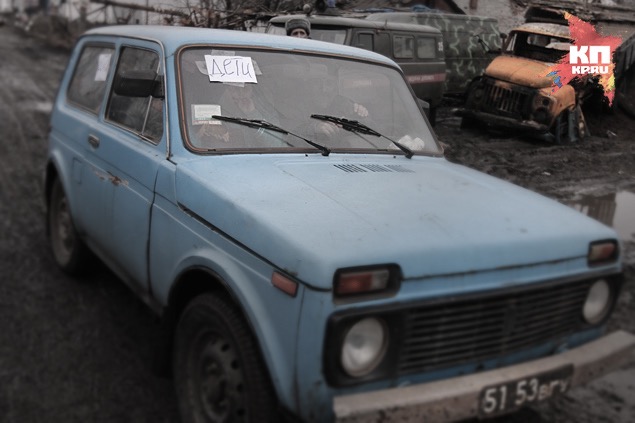
They surround us on all sides, conveying greetings to relatives in Moscow, Tyumen, Sevastopol, Belgorod, Novosibirsk, Kharkov, Odessa. An uncanny call from the survivors to the living. People who have escaped from a real hell share their experiences with us.
“Our friends left yesterday. We were afraid because they shoot you in the back,” a young girl says.
“We were sat in the basement, my brother was killed, they killed my brother!” sobs a young woman with a child. “We sat with the children in a cold basement! Six days we couldn’t come out.”
“Tell Yanochka in Belgorod region, we’re alive, and tell them in Crimea too, we survived,” bellows an elderly lady. “Mister Poroshenko, sit down at the negotiating table. For the sake of our children, our elderly. We can’t suffer any more.”
“This is a city of the dead! For six days we haven’t eaten or drunk, we’ve been going crazy,” another woman is almost shouting. “This is genocide against the people, it’s just killing. Six days they’ve been killing us. My hands are shaking. We tried to alarm people, called the press, told them there were children here. Only the children saved us, thanks to them. But all the same, what kind of a corridor is that—they’re firing from that side! The Ukrainians don’t let us through their side, you can’t escape there. We’re like prisoners to them, as if we’re to blame for something.”
“When the Nazis were leaving the boarding school, they drew fire on themselves,” says a man. “The town was covered with Grads from Debaltsevo. Everything was destroyed.”
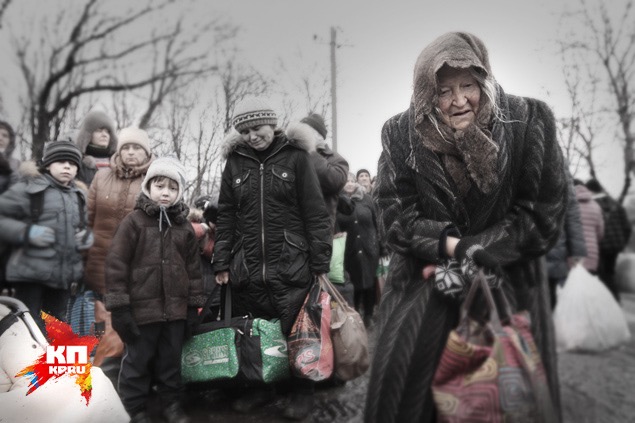
At midday the artillery starts up, throwing shells right over the crowd’s heads. Nobody ducks, nobody even looks up at the sky. They have seen more than this and have seen more than enough. A Militiaman runs up to us:
“Guys, leave as fast as you can. Shells are flying—you hear?”
Somewhere, off to a side, we can hear the sound of explosions. The railway crossing is a pre-sighted target so his concern is more than real. We can see a folded wheelchair being passed over people’s heads in the back of a truck and a very pale man with unnaturally straight legs follows. One of the Militia’s commanders, Gogi, comes for us. In June, we ran with him around the basements of Semyonovka, near Slavyansk, as a tank was hunting our group. Acquaintances like this are difficult to forget even till old age.
Gogi says that the city is enduring the worst that can be imagined in such a situation—“layer cake.” Encircled soldiers from terrorist battalions rightly fearing capture, armed deserters, residual groups not intending to surrender, bitter snipers shooting at any living thing, demonstrating that the UAF has long since lost its presence in the city. Local residents also remain in hiding in basements, making it impossible just to throw a grenade into the house to mop up.
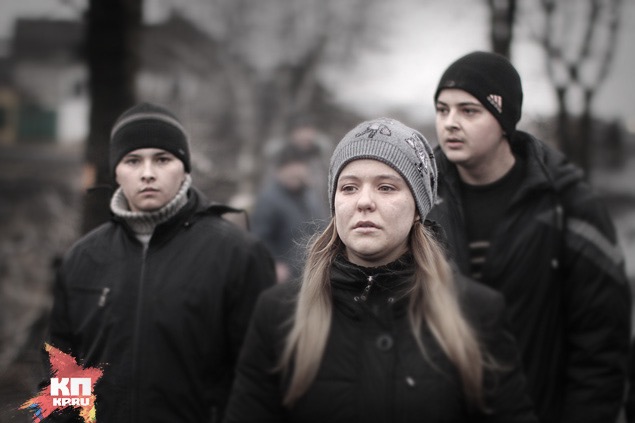
“The situation in the city is grave,” says Gogi. “Last night we evacuated three Urals full of people and more than ten cars. It’s strange that the Ukrainian troops didn’t do it. When they began their retreat, none of them bothered about the civilians. There are very many elderly, pensioners, people who can’t walk. We helped them. A hundred and fifty more people gathered in the morning. Many come here by themselves. There are still around two hundred people in the city, nobody knows exact numbers. We’re checking every building, not so much for Ukrainian soldiers as for civilian survivors. The firing is regular and quite chaotic, it’s difficult to understand what they’re aiming at. They’re firing at residential areas.”
We reach the limits of the residential district and leave the cars by a fence. Gogi commands us:
“Here you have to run twenty metres, there’s a sniper in the window on the ninth floor, he’s still sitting there.”
We run, jumping over the rubbish under our feet—coils of barbed wire, fragments of cable, cords from burnt tyres. To our left—shooting and grenade explosions, the Sparta Battalion “cleaning up” the city districts. Occasional stray bullets whistle somewhere high above our heads.
There was a luxury hotel complex in the way of the DPR Army’s advance. It was partially burnt, partially destroyed. Designer wrought iron lamp-posts had been twisted into knots by a monstrous force. On the fancy rockery amongst the moss and stones there are pieces of human flesh in camouflage rags. Three Ukrainian tankists had not made the few metres to the basement. In the last few months we have seen dozens of children and old people who could not make it to the shelters as well, killed at the entrances to basements, porches or driveways… On the corpse’s breast is a notebook; the wind stirs the pages—they are all empty. And now the city of Uglegorsk is also empty.
http://slavyangrad.org/2015/02/16/the-tragedy-of-uglegorsk-exodus-from-the-city-of-the-dead/
💀✠💣✠💀✠💣✠💀✠💣✠💀✠💣✠💀✠💣✠💀✠💣✠💀✠💣✠💀✠💣✠💀✠💣✠💀✠💣✠💀✠💣✠💀✠💣✠
Visitors to LM:GNC
Leuren Moret: Global Nuclear Coverup
- ❁ Currents
- ⚛ Radiation Omnicide 👥
- 🎥 UC, Davis, Katehi, Illuminati ✠
- 🌎✟☦ One World Religion 🎭
- ♞ Atlanticists v. Putin et al ⚪️
- ✈️ 3 NWO False Flags Connected ➷
- 🔪Ukrainian ✠ Wikileaks 👀 Interview 🎥
- 🚫 Out of Eurasia 🚫
- 💀 Jade Helm, International Implications, NWO Rollouts ⏰
- 🌿 Essential Oils, Nutrition, Frequencies & Health 🌺
- 🎯 R.F.D.E. | H.A.A.R.P. | N.L.P. ⚡️
- ⚛ Leuren Moret: Hiroshima, Nagasaki, Fukushima ⚛
- ❦ Moret & Battis: Jade Helm ❦
- 🌎 New World Order America 🇺🇸
- ⨳ Geopolitics Ukraine | E.U. Judo 🌍
- 👥 Template: Jade Helm
- ✠ America’s Domestic Pacification ✠
- ♨️ Chernobyl, Zaporozhye, Blackmail ⚛
- 💉 REBRANDING DISASTER🔪
- 👤 Eurasian Enigma Arises
- 🔴 Donetsk Nuclear Explosion ⚫️
- 🌍 21st Century Silk Road 🌏
- 🌍 Africa ☗
- ♞ Balkans, The Nameless Triangle
- 🌏 China 🌝
- 🌍 Eurasia 🔴
- 💣 Israel: Out of Erupt!
- ✠ Jesuits/Templar’s Origins & Aims
- 👺 SOROS ✠ NWO 📚 Hacked ✍
- ➴ Pyatt’s ✠ SOROS ♞ Breakfast 🍳
- Breedlove, GOOD RIDDANCE
- 🎱 Obama’s $3 Billion Eurocon 💸
- 🌍 A Psychopath’s Psychopath ✠
- 🔫 Global Hit Squad 💣
- 💀 Neo-Capitalist’s Slave Trade 💰
- 🇺🇸 Bio: Undermine Control
- ↷ Fine Evening For A Minuet ↶
- ✠ Slavery, Then & Now
- 💣 JCS Operation Northwoods
- ✠ The Three Secret Meetings
- Korea Yeonhee (연희) Nuclear Kabuki Theatre
- 🌍 Middle East 💣
- 💣 ISIL: Battered, Retreating 💀
- 🔥 Turkish Coup Attempt 💣
- ⚑ Muslim Brotherhood and ISIS ⚫️
- 🔫💰💉Daesh Terrorist Multi-Tool🔪💣💊
- 🚧 US and Turkey, NWO the Kurds 💸
- ✠ Hitler Bragged on Jesuits ✠
- 🍞 Their Daily Bread & Rubble 💣
- 🔪“Erdogan is Strengthening ISIS”💣
- 🇫🇷 Russia Reveals ISIS’ Money 💰💰
- "Raqqa's Rockefellers” ISIS Full Frontal
- ☞ Smashing Turkey’s Game❌
- 🌍 Juncker | E.U. | Direction ⤣
- 🔪 GLADIO Wolf Kills Russian Pilot ✈︎
- ✈︎ Washington’s SU-24 🎯
- 🌐 Turkey, NATO, War Crime? 🔎
- ➷ 449-Down, ISIL to Go 💣
- 🌎 North America 🔥✠
- 🇷🇺 Russia 🇷🇺
- 🇷🇺 PUTIN OVERHAULS KREMLIN 🏰
- ☛ Who Created ISIS ☚
- 🍳 Food Supply Compromised 🎱
- 🌍 Putin re Ceasefire Syria 🌐
- 👤 Cold War Re-Run 👀
- 🌐 Minsk 101 | Theatre of the Absurd 🌍
- 🌐 Geopolitical Original Sin 🌍
- ♘ Russian Troops | Turkish Border ♘
- 📚 Educating Charlie Rose 🔑
- 🌍 Lavrov's Munich Speech
- 🎱 US Embassy Media Fail 🎭
- ✠ ♛🃏 Putin’s Jar Of Spiders
- 🎱 MOSSAD’S ON THE DOORSTEP 💣
- 📄 This Document is Dynamite 📄
- ♔ The Golden Trap
- ❁ Russian Fusion-Fission
- ❁ Putin’s 7-Point Plan
- ❁ Russian Position Speech
- ✈︎ Ukraine, MH-17, Jesuits Flagged! BRICS Undermined?
- ⏰ Ukraine? 🔥 Bail Out! ✈️
- 💦👤 Psychotropic Zombification ☔️
- 💣 Odessa Trade Union Murders 🔥
- 🃏 Nothing Personal, Just Business 💰
- 💉 BioWeapons for Depopulation 💀
- ⚛ Nuclear Coverup Ukraine | Mines of Zholti Vody 💀
- 🔥 Unsustainable Ukraine 👥
- ☗ ASHES TO ASHES 💀
- 🔪Ukrainian Wikileaks 👀
- ☞ Dispatches From the Front 🔫
- 💣 The Ukrainian Failed State 🌍
- 🔑 Our Decisions Define Us🔑
- ✠ Child Abuse 💀
- 💣 Mozgovoi’s Murder 🔪
- 🎱 Yatsenyuk's Russian Threat 🔮
- ||| Prison Ukraine |||
- ✍ CyberBerkut Reports 👥
- ♨️ Crazy Arseniy’s -USED- Ukraine Fire Sale! ♨️
- ✝ AZOV CRUCIFIXION ✝
- 👤 Eyewitness Debaltsevo Cauldron 💀
- ✍ Historic Slaviansk Doctor Interviewed
- 💀 The Tragedy of Uglegorsk
- ♟ Jan. 2015 Minsk Fail 🃏
- ➷ Tochka Found, Debaltsevo Locked
- 🌍 World Facing Second Chernobyl
- ✈︎ MH-17 AND THE Jesuit Minuet
- ✈︎ MH-17, Jesuits Flagged!, Video
- 💀 Death’s Drummers
- 👤 DPR! Novorossiya Calling
- 💀 Ukraine’s Chernobyl Armor
- 🎱 Gas to Ukraine Blocked
- ❁ Global Nuclear Theatre: Donbass
- ✠ GHOSTS of the 51st BRIGADE
- ❁ Novorossiya: Strelkov Briefing
- 👤 Open Letter to President Putin
- ✈︎ MH-17 Dutch Interim Report
- 💣 Surrendering UA Murdered by Punatives
- ♟ Mutiny of the Euro-Integrators ♟
- ➹ View from Ukraine Operating Room
- ❁ Ukraine’s Violent Escalation
- ❁ Ukrainian Soldier’s Cry for Help
- ⧱ Occupied Ukraine ⧱
- ❁ US State's Nuland Directs Ukrainian Coup
- 📯 Ukraine Deputies Knew Before Maidan
- ❁ Health In 2015
- 💉 Vaccines 💀
- 🎥 Geopolitics, Jesuits & History
- 🎥 Rebranded ✠ The Jesuits ✠
- ⚛ Zaporhyze Nuclear Events & Geopolitics
- ❁ Fukushima Polar Vortex Radiation ❁
- 💀 Embrace, Enfold, Extinguish
- ✈︎ Fear of Flying . . . (1of4)
- ❁ Fukushima: Impact of Fallout On Oceans (Pt.1)
- ❁ Fukushima: Impact of Fallout On Oceans (Pt. 2)
- ❁ North America, Middle East and Fukushima
- ❁ DHS/Napolitano Berkeley Template
- ❁ Fukushima Radiation, Ecocide & Tesla Technology
- ✈︎ Flight 370 Downing
- ✈︎ MH370: The Follow-Up
- ❁ Domestic Radiation Issues
- ❁ Fukushima: Hawaii, Pacific Is. - Unsafe
- ⚛ Fukushima Reactors, Breakdown 1-6 ⚛
- 🌏 International Sites Featuring LM:GNC
- ❁ On To Mongolia 🎥
- 🎥 LKM On Fairdinkum Media 🎥
- ❁ Editorial Page
- ❁ Conversations 📬
- ❁ Waves
- ⚛ Radiation Around The Nation 🌎
- ⚛ Your Radiation #73/74, Sep 10 - 24, 2016 🌎
- ⚛ Your Radiation #71/72, Aug 27 - Sep 10, 2016 🌎
- ⚛ Your Radiation #69/70, July 30 - August 13, 2016 🌎
- ⚛ Your Radiation #67/8,--July 16-30, 2016 🌎
- ⚛ Your Radiation #65-6,--July 2-16, 2016 🌎
- ⚛ Your Radiation #64, July 2-9, 2016 🌎
- ⚛ Your Radiation #62-3, June 18 - July 2, 2016 🌎
- ⚛ Your Radiation #61, June 11-18, 2016 🌎
- ⚛ Your Radiation #60, June 4-11, 2016 🌎
- ⚛ Your Radiation #59, May 28 - June 4, 2016 🌎
- ⚛ Your Radiation #58, May 21-28, 2016 🌎
- ⚛ Your Radiation #57, May 14-21, 2016 🌎
- ⚛ Your Radiation #56, May 7-14, 2016 🌎
- ⚛ Your Radiation #55, Apr 30 - May 7, 2016 🌎
- ⚛ Your Radiation #54, Apr 23-30, 2016 🌎
- ⚛ Your Radiation #53, Apr 16-23, 2016 🌎
- ⚛ Your Radiation #52, Apr 9-16, 2016 🌎
- ⚛ Your Radiation #51, Apr 2-9, 2016 🌎
- ⚛ Your Radiation #47-50, Mar 5 - Apr 2, 2016 🌎
- ⚛ Your Radiation #46, Feb 27-Mar 5, 2016 🌎
- ⚛ Your Radiation #45, Feb 20-27, 2016 🌎
- ⚛ Your Radiation #44, Feb 13-20, 2016 🌎
- ⚛ Your Radiation #43, Feb 6-13, 2016 🌎
- ⚛ Your Radiation #42, Jan 30 - Feb 6, 2016 🌎
- ⚛ Your Radiation #41, Jan 23-30, 2016 🌎
- ⚛ Your Radiation #40, Jan 16-23, 2016 🌎
- ⚛ Your Radiation #39, Jan 9-16, 2016 🌎
- ⚛ Your Radiation #38, Jan 2-9, 2016 🌎
- ⚛ Your Radiation #37, Dec 26 - Jan 2, 2015|16 🌎
- ⚛ Your Radiation #36, Dec 19-26, 2015 🌎
- ⚛ Your Radiation #35, Dec 12-19, 2015 🌎
- ⚛ Your Radiation #34, Dec 5-12, 2015 🌎
- ⚛ Your Radiation #33, Nov 28 - Dec 5, 2015 🌎
- ⚛ Your Radiation #32, Nov 21-28, 2015 🌎
- ⚛ Your Radiation #31, Nov 14-21, 2015 🌎
- ⚛ Your Radiation #30, Nov 7-14, 2015 🌎
- ⚛ Your Radiation #29, Oct 31 - Nov 7, 2015 🌎
- ⚛ Your Radiation #28, Oct 24-31, 2015 🌎
- ⚛ Your Radiation #27, Oct 17-24, 2015 🌎
- ⚛ Your Radiation #26, Oct 10-17, 2015 🌎
- ⚛ Your Radiation #25, Oct 3-10, 2015 🌎
- ⚛ Your Radiation #24, Sep 26 - Oct 2, 2015 🌎
- ⚛ Your Radiation #23, Sep 19-26, 2015 🌎
- ⚛ Your Radiation #22, Sep 12-19, 2015 🌎
- ⚛ Your Radiation #21, Sep 5-12, 2015 🌎
- ⚛ Your Radiation #20, Aug 29 -Sep 5, 2015 🌎
- ⚛ Your Radiation #19, Aug 22-29, 2015 🌎
- ⚛ Your Radiation #18, Aug 15-22, 2015 🌎
- ⚛ Your Radiation #17, Aug 8-15, 2015 🌎
- ⚛ Your Radiation, August 1-8, 2015 🌎
- ⚛ Your Radiation, July 24-31, 2015 🌎
- ⚛ Your Radiation, June 26 - July 24, 2015 🌎
- ⚛ Your Radiation, June 19-26, 2015 🌎
- ⚛ Your Radiation, June 12-19, 2015 🌏
- ⚛ Your Radiation, June 5-12, 2015 🌎
- ⚛ Your Radiation, May 29 - June 5, 2015 🌎
- ⚛ Your Radiation, May 22-29, 2015 🌎
- ⚛ Your Radiation, May 15-22, 2015 🌎
- ⚛ Your Radiation, May 8-15, 2015 🌎
- ⚛ Your Radiation, May 2-8, 2015 🌎
- ⚛ Your Radiation, April 24 - May 1, 2015 🌎
- ⚛ Your Radiation, April 17-24, 2015 🌎
- ⚛ Your Radiation, April 9-16, 2015 🌎
- 🔥 Fire at Oak Ridge 💥
- 💥 NANOWEAPONRY 💥
- 🐄 Radioactive Cattle Teeth, Fukushima 🏭
- 📰 WikiLeaks 🔎 NSA and More 🔦
- ✨Nano ‘Hall of Mirrors’⚡️
- ⚛ 💀 ⚛ into the Hudson River 🌎
- 🚿 Flint, Metropolitan Eugenics 💀
- 🌍 Existential Threat? ☛NATO☚
- 💉 Gates, Poroshenko; Conspiracy, Government 🎯
- 💉 Gates-Poroshenko ZPG Ukraine 💀
- 💀 Paris Massacre Perpetrators 👤
- 🔪 Delgado, Mind Control ♟
- 🌎 MOST NUKED NATION ON EARTH 🌎
- 🎯 Radio Frequency Directed Energy 🎯
- ⚛ Please, Don’t Pick the Mutants 🌻
- ⨳👤⨳ Space-Based Weapons Ban
- √ Saudi OP Strategy Success
- ♨️ Gallery ♨️ Chernobyl Fire ♨️ 2015 ♨️
- 🌍 Monsanto Backdoors E.U.
- 🎉 Crimea’s 1st Anniversary Album 🎉
- 🌏 21st Century Eschalon
- 📰 International Headline Watch 🌏
- ✄ Prouty Place ✑ CUT THE BULL ✂︎
- 🌏 How To Wreck The Environment
- 🇯🇵 Plutonium Isotopes Off Japan
- 🌍 Depopulation Agenda: Europe 👤
- 🔪💉Cease Covert Depopulation Letter🔪💉
- ❁ Dutch Apologize for MH-17 Lies
- ❁ Pacific Dead from Fukushima
- ❁ Strange Fish Story
- ❁ Blood Composition of Monkeys Altered Near Fukushima
- ❁ Secret Army Bases
- ⚛ Fukushima Plutonium Effect ⚛
- ➷ RAND Demographic Military Power ➷
- ⚛ Depleted Uranium | DNA Damage ⚛
- ❁ Hidden Genocide: by Dr. Ernest Sternglass
- ❁ Space Preservation Act of 2001
- ❁ 1972 Rothschild Ball
- ❁ Unsafe Radwaste Disposal
- ♆ Fallout and Reproduction of Ocean Fish Populations
- ⚛ Radiation Around The Nation 🌎
- ❁ Lifestyle
- ❁ Archive
- ⚛ 61 Years of Omnicide ⚛
- 📻 Nanoparticle Toxicity with Leuren Moret ❦
- ❁ New Bombs and War Crimes in Fallujah
- ❁ Global Climate Change . . .
- ⚛ International Radiation Distribution ⚛
- 💀 Depleted Uranium’n’DNA 😱
- ❁ UC Regents Lose Nuke Pgm
- ❁ DU-Trojan Horse
- ❁ LM:GNC (Pt1)
- ❁ LM:GNC (Pt2)
- ❁ World Uranium Weapons Conference 2003
- ⚛ Radionuclide ReMobilization Abatement
- ❁ "America First" Transcription
- ❁ "Whale Archive" Transcription
- ⚛ ⚛ ⚛ Location, Leuren Moret: Global Nuclear Coverup ⚛ ⚛ ⚛
- ❁ Glossary
- ❁ Contact
# # #
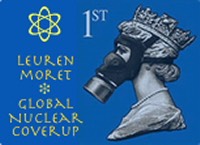
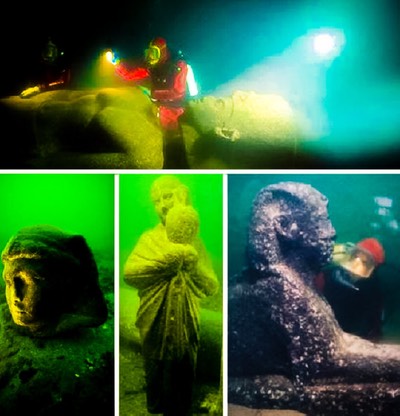

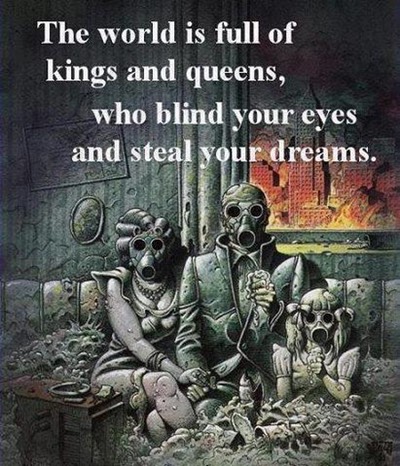
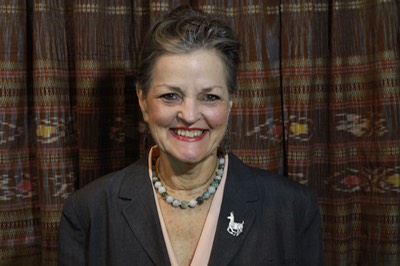
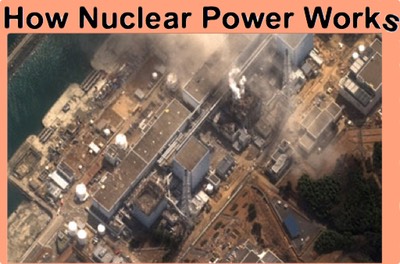
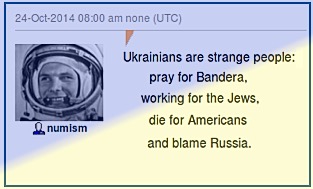

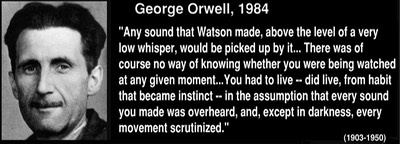
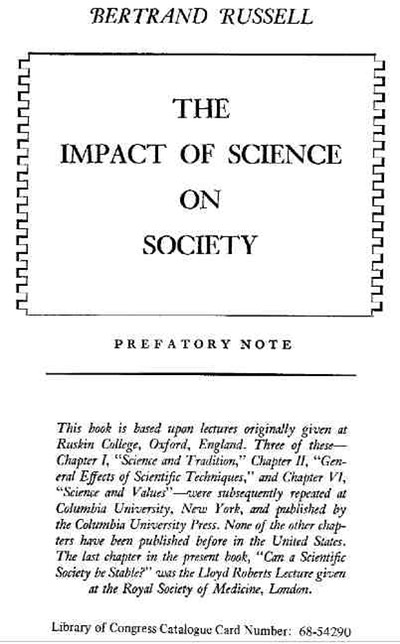
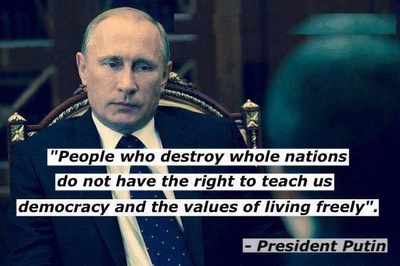
![20120724 - 7-24-2012 The More We Learn - quote from David Rockfeller -_thumb[2]](../../_Media/20120724---7-24-2012-the_med_hr.jpeg)



